Pharm Exec's 16th Annual Industry Audit
With our latest review indicating declines in shareholder value and shareholder value to sales, those companies that score well in critical profit management metrics such as return on invested capital are best positioned to maintain that crucial edge in performance execution.
Playing the Long Game: With our latest review indicating declines in shareholder value and shareholder value to sales, those companies that score well in critical profit management metrics such as return on invested capital are best positioned to maintain that crucial edge in performance execution
Compared to the previous year, 2016 came up a bit short when measuring economic performance, according to Pharm Exec’s latest Industry Audit examining the business of biopharmaceuticals. The life sciences sector, however, still stands out compared to other industries, as it continues to outpace the overall US economy.
As in past years, Pharm Exec’s 16th annual Audit presents a unique perspective on biophama performance, with its focus on shareholder, or enterprise, value-an organization either creates shareholder value or they destroy it. The goal of the Audit is to rank the top publicly traded biopharma companies across 10 metrics, most of them financial. There are 23 publicly traded companies (the “PE 23”) that make up this year’s rankings.
The metric of sales revenue is used as the starting point. From there, a number of metrics are incorporated that do not commonly appear in other financial output lists. For example, return on assets is highlighted-a much more important metric than simply net profits. Also featured is return on invested capital, which measures how well a company is managed, not just how its stock value can be driven by a feeding frenzy due to activist stock trading that can send the price of stock soaring, but have nothing to do with how a company is managed for profitability.
Methodology
This year’s performance analysis relies on reported information for the 2016–2015 time period. The metrics are also weighted reflecting their relative importance in assessing a company’s performance. Some metrics are more important than others. The “Big Three” metrics are: growth in shareholder (enterprise) value; ratio of enterprise value to sales; and return on invested capital. Each of these metrics is weighted at a Three.
The remaining metrics, each weighted as a Two, are: sales growth; gross margin; net profit to sales; sales to assets, and return on assets.
Two non-weighted metrics are used as well. One is sales, general and administrative (SGA) expenses to sales revenue. This metric does not factor into assessing company performance. The reason is that in any one year, or two, a firm may be launching a new product or revising its marketing or branding strategy. For that time period, SGA outlays may need to increase and can be justified as an investment in growth.

However, over a longer time period, SGA spend should not outpace sales growth. If that happens, a company is getting bloated and becoming less productive and less efficient. Still, SGA to sales is an important metric to track.
The other non-weighted metric is profit per employee. This metric has less to do with how well a firm is managed, but it does reflect how productive a firm’s employees are. The Audit has developed this metric because human capital is a vital differentiator for an industry that relies increasingly on knowledge-based intangibles such as IP to create the most profitable products.
In summary, the Audit consists of three metrics with a weight of Three, which indicates their higher relative importance to shareholder performance compared to the metrics that carry a weight of Two. The higher a company performs on each metric is reflected in a ranking based on the number of points it receives. The highest placing for each metric is 23 and the lowest is one. For example, if a firm places 22 out of the 23 on a key metric like enterprise value to sales, the company receives 66 points on that metric, given its 22 ranking with a weight of 3 (22 rank × 3 = 66 points). In another example, if a firm comes in at a ranking of six, toward the bottom, on the metric sales growth, with a weight of Two, the company’s total points would be 12 (6 ranking × 2 = 12 points). Each of the 23 company’s points-based placement per metric are totaled to arrive at an overall ranking to determine which of the 23 receives the most points to become this year’s winner.
Finally, in addition to these 10 performance metrics, the Audit includes several benchmarks that compare the biopharma sector as a whole to other industries as well as the 23 individual biopharma companies in this year’s list. For example, how do the biopharma sector and the 23 firms figure in comparison to the overall picture of the US economy and inflation? Then there are more specific indices related to economic performance such as the Dow Jones, Standard & Poor, Nasdaq, and others.
‘Macro’ benchmarks
If a biopharma company can’t beat the growth of the US economy and the US Consumer Price Index (CPI), then it is in trouble. For 2016, the US economy expanded about 2% and the rate of inflation also increased about the same. In comparison, the PE 23 substantially outpaced the US economy, growing at 8.8% in sales revenue. The group fared far better than the Fortune 500 in 2016, whose growth was at negative 1%.
Sales growth
Table 1 (right) shows sales growth for 2015-2016. Revenue from sales is always good to have, but it tells us
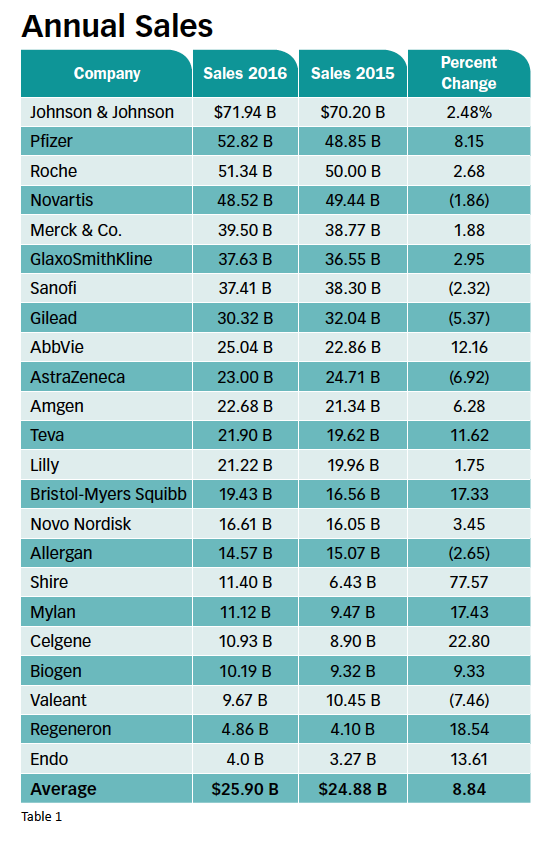
little about how well a company performs. For instance, AbbVie’s sales in 2016 are $5 billion lower than Gilead’s, but AbbVie’s enterprise value, or market capitalization, is $20 billion higher. As the old adage states, “either you grow or you die.” Note in Table 1 that six companies experienced negative growth. Mergers and acquisitions also drive increases in sales as opposed to organic revenue generation that come from within a firm’s in-house labs.
Enterprise value and enterprise value percentage growth
Table 2 (below) on enterprise value (EV) shows that the average change for 2016 for the PE 23 was negative 4.3%, vs. 6.8% growth in 2015. Twelve of the PE 23 went backward in EV.
EV is directly related to shareholder value, and is derived from market capitalization (the number of common stock shares outstanding multiplied by the price of the stock on a given day), plus cash and cash-like assets, minus debts and liabilities. The higher the ratio is, the higher the value of the company. The most valuable biopharma firm in the world is Johnson & Johnson, with an EV at the end of December 2016 of $327 billion, an increase of 23.6% over 2015.
As mentioned, EV is analogous to market capitalization and both numbers are close. For example, Pfizer’s EV for 2016 was $227 billion; its market capitalization was $203 billion. Across the Fortune 500 list, market capitalization increased an average of 11.7% in 2016 from the previous year.
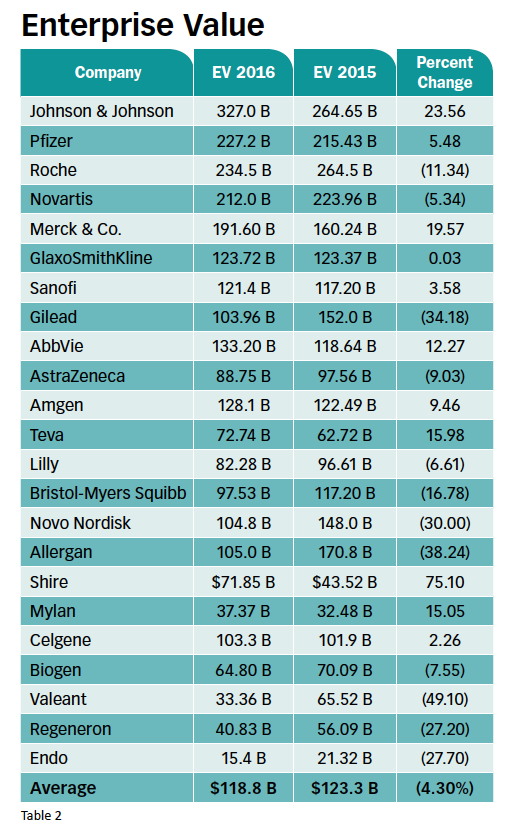
Enterprise value to sales
The EV/sales ratio reflects a market assessment of future growth and profitability. The higher the ratio suggests that a firm’s best days are ahead; the lower the ratio, it means the firm has hit a mature phase where growth and/or profitability has peaked. Table 3, EV to sales, shows the average ratio for 2016 was 4.87 times sales, compared to 5.82 times sales in 2015. This reinforces the drop in shareholder value. Only five companies increased on this critical metric.
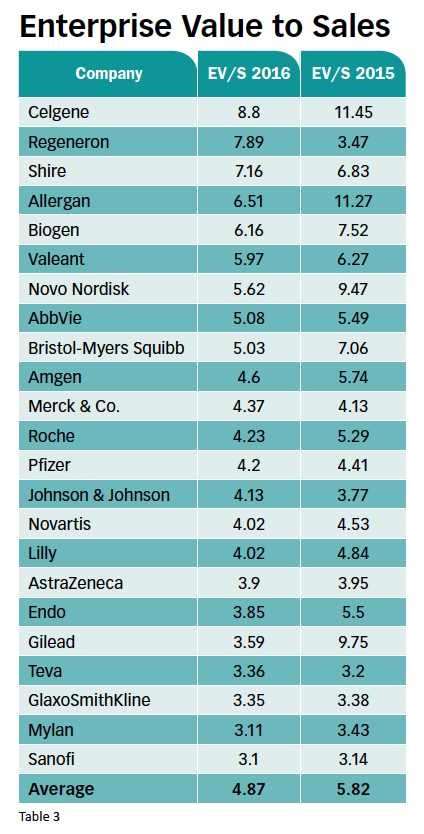
Gross margin
Table 4 shows gross margin, defined as sales revenue minus cost of goods sold. This metric reflects a firm’s ability to price. The higher gross margin, the more power the company has to raise prices. Average gross margin for the PE 23 in 2016 was 68.96%, a slight increase from 68.7% for 2015. The figure is impressive, nonetheless, given the industry’s hostile pricing environment.
Warren Buffet characterizes pricing power as “the moat surrounding and protecting your castle.” The ability to raise price and keep prices high is seen among the stratospheric pricing levels of Gilead, AstraZeneca, Amgen, Novo Nordisk, Celgene, Biogen, and Regeneron. These companies are masters of their pricing domains.
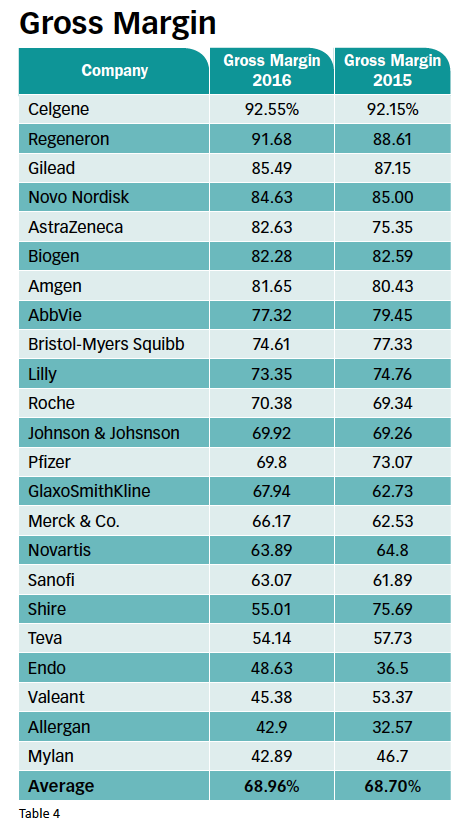
Net income to sales
Table 5 is an indicator of profitability-earnings before interest, taxes, depreciation, and amortization (EBITDA) in relation to sales revenue. Net profit is arrived at after subtracting operating expenses from gross margin. Net profit to sales is your profit margin.
The profit margin measures how well the company deals with sales, pricing, cost of goods sold for ingredients used in manufacturing its products, operating expenses, and discounts, rebates, and royalties, if any. If a company cannot grow revenues, the appropriate management fallback response is to get a better handle on operating expenses. Overall profitability for the PE 23 decreased from 22.5% in 2015 to 19.92% in 2016. Nevertheless, the biopharma industry is a very profitable sector when comparing the 19.92% profit margin to the Fortune 500 average profitability of about 8%.
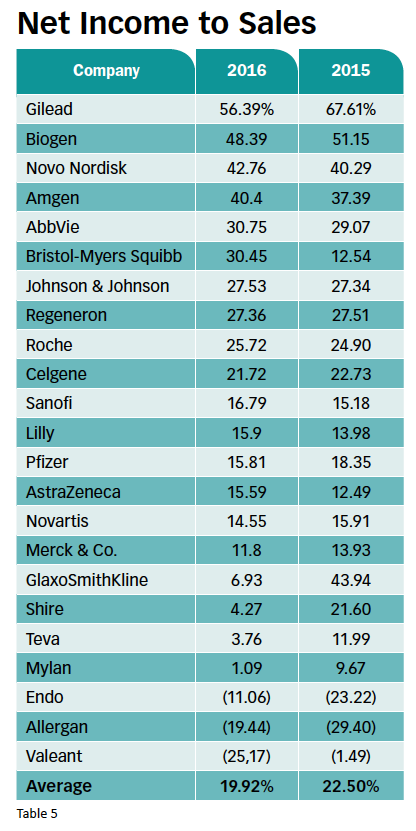
Sales to assets
Table 6, asset management, relays how well a firm handles managing its collective assets, including cash, accounts receivable, property, equipment, and inventory. The ratio reflects what a firm gets back in return for every dollar it invests in these assets. Setting the high bar at the top of Table 6 once again is Novo Nordisk, with a sales to assets ratio of 1.18; that is, for every dollar Novo Nordisk invests in assets, it generates $1.18 in return. The average sales to assets ratio for 2016 was 0.447, reflecting a decrease from 2015 in managing assets on the balance sheet.
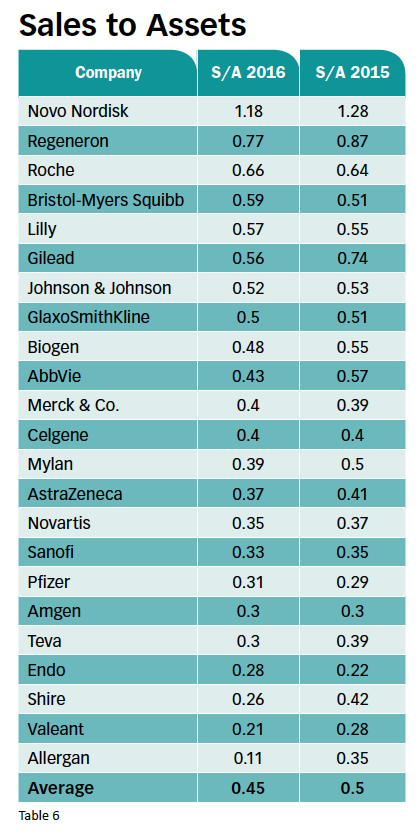
Return on assets
When you multiply profit to sales times sales to assets, you get profit to assets, a very important metric. Table 7, return on assets, is much more informative than just the profit margin because it measures how well a company is managed; that is, how good the firm is at not just margin management, but at effectively deploying its assets as well.
Table 7 shows Novo Nordisk with a stunning return on assets metric of 40.06. To put this in perspective, Novo Nordisk’s return on assets is on par with other companies’ gross margins.

Return on invested capital
As with return on assets, Table 8, return on invested capital (ROIC), is a measure of how well a firm is managed. No financial gimmickry here, just the result of how good management is at investing in assets and getting a return on those assets through solid strategies and execution. ROIC dropped from 16.78% on average for the PE 23 in 2015 to 13.85% in 2016. Gilead’s number fell to 31.78% from 53.98% the year before, along with a sharp drop in shareholder value and the EV to sales ratio due to the leveling off of the hepatitis C drug wave. Novo Nordisk’s ROIC of 82.23% is almost incomprehensible when you consider that for many biopharma companies that number would be a respectable gross margin; Novo Nordisk hits that number at the ROIC level.
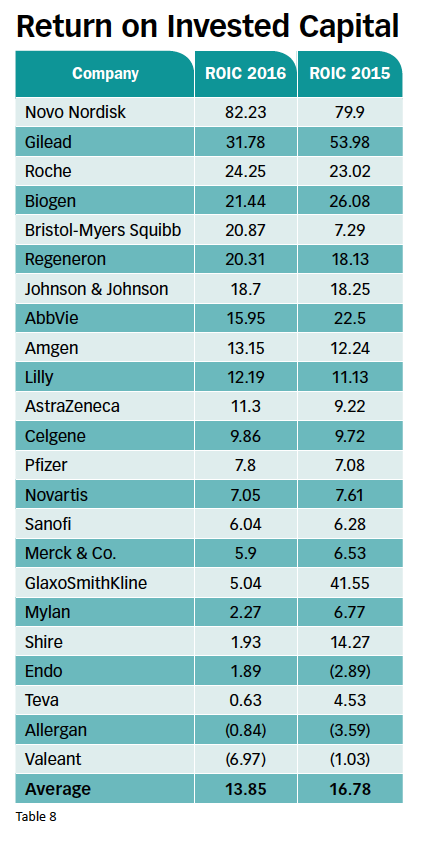
Also, it’s worth comparing the ROIC and return on assets that measure performance to financial machinations such as stock buybacks and dividend gifts. Such maneuvers lift earnings per share and, correspondingly, price to earnings-but without necessarily investing in the business for long-term gain.
Net profit per employee
Table 9 shows the profit generated per employee, which is a reliable measure of productivity. Gilead is at the top here, with each employee producing $1.5 million in profit for 2016. There is a dropoff to the No. 2 and 3 spots, where Biogen and Amgen delivered $699,000 and $601,000, respectively, per employee. Put those three company’s numbers in perspective, Apple’s profit per employee is about $500,000. Big box retailer WalMart’s profit per employee is about $7,000.
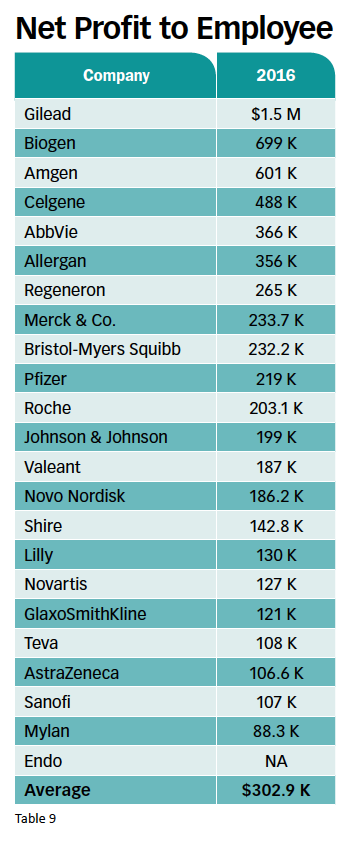
Selling, general and administrative expenses to sales
Table 10 shows a very important metric: SGA to sales. It’s strategically prescient, even though it is less useful in measuring year-on-year performance. In general, SGA growth should not exceed growth in sales or it will start cutting into profitability. Another word for SGA is “overhead,” and when this is above average for the sector or increasing at a faster pace than sales, the firm becomes bloated and less productive. The reason why the Audit does not weigh this metric is that for a given, or short, time period, a company may need to pump more money into promotion or marketing or provide money for litigation and other similar expenses. Hence, over a defined period, SGA can exceed sales growth. In Table 10, we see that the companies on this year’s list are slowing the rate of SGA growth incrementally. SGA averaged 42.8% of sales in 2015, slightly decreasing to an average of 42.46% in 2016.
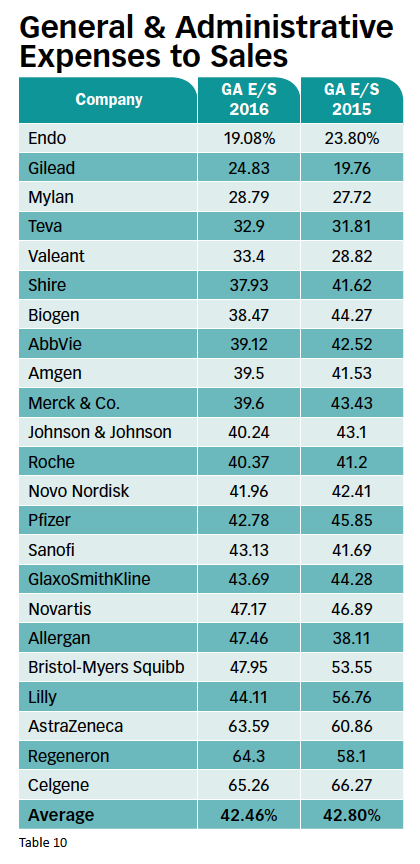
Despite not factoring into the PE 23 scoring, SGA to sales is a critical metric, nonetheless. The total estimated amount that large biopharma companies will need to reduce their SGA from 2016 through the end of 2017 to maintain present levels of profitability is $36 billion, according to the IMS Institute for Healthcare Informatics. This reinforces McKinsey & Co.’s ongoing analysis of healthcare productivity. Productivity rates for healthcare overall since 1990 have dropped by negative 0.8%, while average employment has gone up by 3%.
SGA is comprised of operating expenses such as marketing and advertising spend. As a way to gauge whether SGA expenditures are justified, companies may look at their income statements and scrutinize the number of ad agencies they are working with; if the number can be reduced, that could lead to savings in SGA. The supply chain can be looked to for savings and efficiencies, as each supplier’s value chain, or gross margin, impacts operating expenses.
Note how high the SGA is for self-proclaimed biotechs like AstraZeneca, which, in its case, is 20 percentage points higher than the group average of 42.8%. Also look, for example, at GlaxoSmithKline. The company is incurring substantial restructuring costs as it integrates 12,000 employees into its consumer and vaccine businesses while trying to offset those SGA costs by reducing the number of drug packaging variants and streamlining its external supply chain network.
And the points champion is ...
Our final Table 11 reveals the winner for 2017: Regeneron. The New York-based biotech came out on top in 2014 as well. Rounding out the top five companies this year are Biogen, Novo Nordisk, Celgene, and Bristol-Myers Squibb.
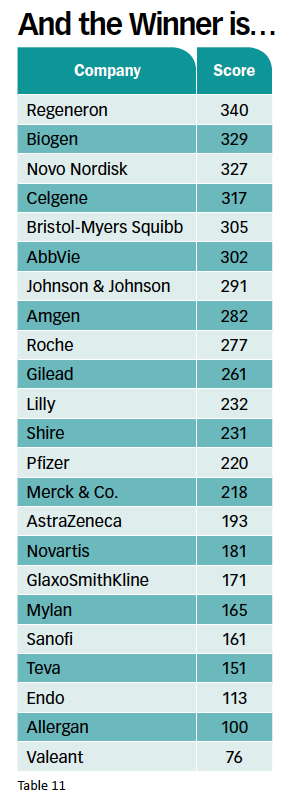
Regeneron continues to see sales grow for its flagship drug, Eylea, domestically and globally. Its cardiovascular and dermatitis treatments have growth potential as well. Regeneron’s SGA to sales ratio is very high, but the company is in a growth mode.
Biogen’s sales growth was stagnant for 2016 and two key metrics, EV growth and EV to sales dropped. Biogen, however, was able to maintain a high markup for its drugs and the company’s ROIC was at the higher
Biopharma vs. high-tech; click to enlarge
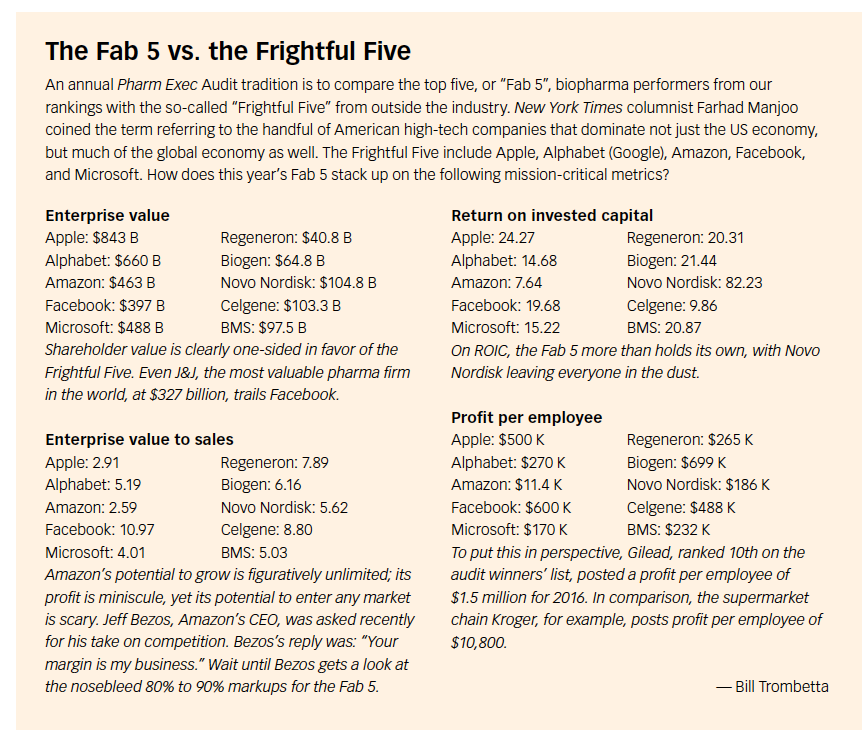
levels.
Novo Nordisk’s performance in EV growth and EV to sales was similar, but its ability to perform at the highest level of asset management was notable. The company increased its ROIC as well.
Celgene was the second-highest sales growth performer. Its EV increased slightly while EV to sales dropped. Celgene’s gross margin is in nosebleed territory, even higher than Regeneron’s.
BMS demonstrated relatively high sales growth, but shareholder value and EV to sales slid due to what is plaguing all high-cost biopharma firms: payer resistance and downward pressure on pricing. Still, BMS demonstrated the highest increase in profitability, while its ROIC almost trebled.
Bill Trombetta, PhD, is Professor of Healthcare Marketing at St. Joseph’s University Haub School of Business in Philadelphia. He can be reached at trombett@sju.edu

Cell and Gene Therapy Check-in 2024
January 18th 2024Fran Gregory, VP of Emerging Therapies, Cardinal Health discusses her career, how both CAR-T therapies and personalization have been gaining momentum and what kind of progress we expect to see from them, some of the biggest hurdles facing their section of the industry, the importance of patient advocacy and so much more.

.png&w=3840&q=75)

.png&w=3840&q=75)



.png&w=3840&q=75)



.png&w=3840&q=75)




















